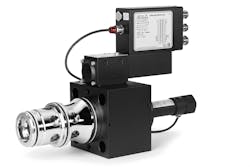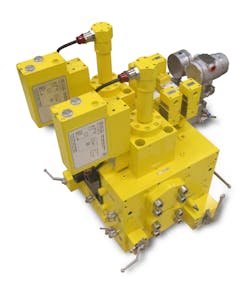Atos has developed a range of explosion-proof electrohydraulic components which benefit use in a range of applications such as mooring systems for oil & gas vessels. They are designed to provide high-performance control and simplified maintenance while offering the corrosion resistance and heavy equipment handling required of the application.
Features of the explosion-proof electrohydraulics include:
- provides high-performance motion control
- high corrosion resistance via zinc-based surface treatment, reaching up to 600 hours in salt-spray test
- on-board digital technology enables development of smart systems
- industry certifications such as SIL2/SIL3 according to IEC 61508, TÜV, DEKRA, UL and more.
Complete Range of Rugged Electrohydraulics
The portfolio of explosion-proof electrohydraulics includes individual components — such as pumps, proportional and on-off valves and cylinders — as well as complete systems. On-board electronics enable these electrohydraulic components to provide a high level of accuracy for motion control as well as the ability to create smart systems.
The proportional valves, for instance, feature on-board digital technology including a built-in oscilloscope for advanced diagnostics, high performance axis and p/Q control. Inductive proximity sensors are integrated into the portfolio's directional valves which allows monitoring of the spool position.
To ensure high corrosion resistance in marine and other harsh applications where explosion-proof hydraulics are required, Atos utilizes a zinc-based surface treatment on its electrohydraulic components. It has demonstrated the ability to protect components up to 600 hours in salt spray tests. For applications where higher corrosion resistance is required, components are made using stainless steel.
Atos' explosion-proof components meet various industry certifications, as well, further ensuring their ability to meet the requirements of harsh environment applications. These include ATEX, TÜV, DEKRA, UL, CSA, ABS, BV, DNV GL, RINA. The solenoid valves in the range are certified up to SIL2/SIL3 according to IEC 61508.
Benefits to Mooring Systems and Other Harsh Environment Applications
With their motion control capabilities and durable designs, the explosion-proof electrohydraulic components suit a range of harsh environment applications in the energy, oil & gas, and mining industries.
One such example is for the use of mooring systems utilized on offshore vessels for petroleum and gas production. These systems enable any floating platform to be safely held in position, explains Atos which minimizes safety issues or potential damage caused by rough seas. These systems come in many forms, but all require high levels of corrosion resistance, application of various international standards, and use of explosion-proof certified components.
Explosion-proof hydraulics are commonly used for the actuation of mooring systems. Use of electrohydraulic versions can provide higher levels of motion control due to their inclusion of electronics which also helps to reduce the amount of maintenance necessary as there are fewer moving parts.
READ MORE: Digital Electrohydraulics
According to Atos, a typical explosion-proof electrohydraulic system for mooring applications is comprised of a central hydraulic power unit (HPU), various hydraulic manifolds and solenoid valves for every aspect of actuation. For these valves, on/off versions are used for simpler or auxiliary movements and proportional valves or cartridges for higher performance needs.
For these systems, Atos says the manifolds, valves and actuators are typically protected against corrosion using dedicated marine painting cycles with thicknesses up to 300 μm; piping and fittings tend to be made of stainless steel. In applications requiring higher levels of durability or in which the mooring system is operating in low temperatures, stainless steel valves are common.






